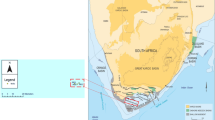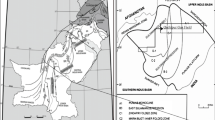Abstract
Absence of a permeability log necessary to assess reservoir quality and injectivity for potential CO2 storage in the heterogeneous and complex South Georgia Rift (SGR) basin provides the motivation for this study. The focus of this study was on the Triassic-Jurassic red beds buried, entrenched beneath the Cretaceous-Cenozoic Coastal Plain sediments. Moreover, the significant cost typically between $10 M and $100 M associated with drilling and logging for in situ permeability coupled with the limited resolution of existing core data further makes this work necessary. The purpose is to relate, use the interpretation of the predicted permeability distribution to assess feasibility for safe and long-term CO2 sequestration. This study also intends to establish the impacts of active and passive tectonism that has shaped and/or re-shaped the evolution of the basin on the present-day permeability. A methodology was applied that utilizes the pore space and geohydraulic properties of the reservoir from existing laboratory and well data to produce a newly derived permeability log. It shows a non-uniform distribution with depths possibly due to geologic changes in the confined and heterogeneous red beds. The derived log displays characteristics consistent with observations from the porosity and resistivity logs. The interpretation of these logs provides evidence for the presence of low permeable, tightly cemented, and compacted red beds. We conclude that the low permeability aided by the low resistivity depicted in the red beds suggests increased confining stress and reduced injectivity, and that the uncharacteristically low permeability reflects a deformed basin shaped with episodes of uplift and erosion.









Similar content being viewed by others
References
Akintunde OM, Knapp CC, Knapp JH, Heffner DM (2013a) New constraints on buried triassic basins and regional implications for subsurface co2 storage from the seisdata6 seismic profile across the south east georgia coastal plain. Environ Geosci 20(1):1–13
Akintunde OM, Knapp CC, Knapp JH (2013b) Petrophysical characterization of the South Georgia Rift basin for supercritical CO2 storage: a preliminary assessment. Environ Earth Scie 70(7):2971–2985
Alam MM, Fabricius IL, Prasad M (2011) Permeability prediction in chalks. Am Assoc Pet Geol Bull 95:1991–2014
Amaefule JO, Altunbay M, Tiab D, Kersey DG, Keelan DK (1993) Enhanced reservoir description: Using core and log data to identify hydraulic (flow) units and predict permeability in uncored intervals/wells. Soc Pet Eng Paper 26436:1–16
Archie GE (1942) The electrical resistivity log as an aid in determining some reservoir characteristics: transactions of the American Institute of Mining. Metall Pet Eng 146:54–62
Bachu S, Gunter WD, Perkins EH (1994) Aquifier disposal of CO2: hydrodynamic and mineral trap**. Energy Convers Manag 35:269–279
Brantley D, Shafer J, Lakshmi V (2015) CO2 injection simulation into the South Georgia Rift Basin for geologic storage: A preliminary assessment. Environ Geosci 22:1–18
Brantley D, Waddell M, Shafer J, Lakshmi V (2016) Inclusion of Faults in 3-D numerical simulation of carbon dioxide injection into the south georgia rift basin South Carolina. Int J Earth Sci Geophy 2:1–11
Burruss RC, Brennan ST, Freeman PA, Merrill MD, Ruppert LF, Becker MF, Herkelrath WN, Kharaka YK, Neuzil CE, Swanson SM, Cook TA, Klett TR, Nelson PH, Schenk CJ (2009) Development of a probabilistic assessment methodology for evaluation of carbon dioxide storage: USGS. Open File Report 1035:1–44
Chowns TM, Williams CT (1983) Pre-Cretaceous rocks beneath the Georgia coastal plain: Regional implications, in G. S. Gohn, ed Studies related to the Charleston, South Carolina, earthquake of 1886: Tectonics and seismicity: U.S. Geological Survey Professional Paper 1313:L1–L42
Global Carbon Capture and Storage (CCS) Institute. (2019) The Global Status of CCS. Australia. pp 4–46
Gohn GS (1983) Geology of the basement rocks near Charleston, South Carolina: Data from detrical rock fragments in lower Mesozoic(?) rocks in Clubhouse Crossroads test hole #3, in G. S. Gohn, ed Studies related to the Charleston, South Carolina, earthquake of 1886: Tectonics and seismicity: U.S. Geological Survey Professional Paper 1313:E1–E22
Gohn GS, Houser BB, Schneider RR (1983) Geology of the lower Mesozoic(?) sedimentary rocks in Clubhouse Crossroads test hole #3 near Charleston, South Carolina, in G. S. Gohn, ed Studies related to the Charleston, South Carolina, earthquake of 1886: Tectonics and seismicity: U.S. Geological Survey Professional Paper 1313:D1–D17
Gomez TC, Dvorkin J, Vanorio T (2010) Laboratory measurements of porosity, permeability, resistivity, and velocity on fontainebleau sandstones. Geophysics 75(6):E191–E204
Heffner DM, Knapp JH, Akintunde OM, Knapp CC (2012) Preserved extent of Jurassic flood basalt in the South Georgia Rift: A new interpretation of the J horizon. Geology 40:167–170
Hovorka SD, Smyth RC, Paine J, Tinker S, Duncan I (2006) Downscaling capacity estimates from a regional to a site scale - case study in the South Eastern US Gulf coast carbon center at the bureau of economic Geology. University of Texas, Austin
Intergovernmental Panel on Climate Change (2018) Global warming of 1.5°C. A special Report on the impacts of global warming of 1.5°C above pre-industrial levels and the necessary global greenhouse gas emission pathways that include carbon capture and storage to mitigate the threat of climate change. https://www.ipcc.ch/sr15/. Accessed 26 May 2021
Lucier A, Zoback MD, Gupta N, Ramakrishnan TS (2006) Geomechanical aspects of CO2 sequestration in a deep saline reservoir in the Ohio River Valley region. Environ Geosci 13:1–19
Marine W (1974) Geohydrology of buried Triassic basin at Savannah River Plant, South Carolina. Am Asso Petrol Geol Bull 58:1825–1837
Marine W, Siple GE (1974) Buried triassic basin in the central savannah river area. J Geol Soc of American Bulleting 85:311–320
Mavko G, Mukerji T, Dvorkin J (2003) The Rock Physics Handbook-Tools for seismic analysis in porous media. Cambridge University Press, Cambridge, p 329
McBride JH, Nelson KD (1989) Brown LD Evidence and Implications of an Extensive Early Mesozoic Rift Basin and Basalt/diabase Sequence beneath the Southeast Coastal Plain. Geol Soc Amer Bull 101:512–520
Olsen PE, Froelich AJ, Daniels DL, Smooth JP, Gore JW. (1991) Rift basins of early Mesozoic age: Geology of the Carolinas, Carolina Geological Society 50th Anniversary, Volume, Ed Horton, p. W 142–170
Prasad M (2003) Velocity-Permeability Relations within Hydraulic Units: Geophysics 68:108–117
Schon JH (2011) Physical Properties of Rocks. Elsevier, Amsterdam, p 350
Talwani P, Chen L, Gahalaut K (2007) Seismogenic Permeability, ks. J Geophys Res 112:B07309. https://doi.org/10.1029/2006JB004665
Telford WM, Geldart LP, Sheriff RE (2001) Applied Geophysics. Cambridge University Press, Cambridge, p 770
Weatherford Laboratories Reports (2014) Geologic Characterization of the South Georgia Rift basin for source proximal CO2 storage based on analysis of samples from Rizer #1 test borehole Colleton County, South Carolina, and the United States Geological Survey Clubhouse Crossroads test hole no. 3. South Carolina, Dorchester County, p 149
Zoback MD, Gorelick SM (2012) Earthquake triggering and large-Scale Geologic Storage of carbon dioxide. Proc Nation Acad of Sci USA 109:10164–10168
Acknowledgements
We thank John Shafer, Mike Waddell, Adrian Addison, Duke Brantley, Mark Evans, David Heffner, Scott Howard, and Bill Clendenin for their contributions to this study. We also thank Professor Manika Prasad of the Colorado School of Mines in Golden, Colorado, for access to their Rock Physics Laboratory facilities. The thin sections that we used were provided by Dr. James Rine of the Weatherford Laboratories. We acknowledge the helpful comments from our anonymous reviewers. This material is based upon work supported by the United States Department of Energy (DOE) under Award Number DE-FE0001965. This paper was prepared as an account of work sponsored by an agency of the United States Government. Neither the United States Government nor any agency thereof, nor any of their employees, make any warranty, express or implied, or assume any legal liability or responsibility for the accuracy, completeness, or usefulness of any information, apparatus, product, or process disclosed, or represents that its use would not infringe privately owned rights. Reference herein to any specific commercial product, process, or service by trade name, trademark, manufacturer, or otherwise does not necessarily constitute or imply its endorsement, recommendation, or favoring by the United States Government or any agency thereof.
Author information
Authors and Affiliations
Corresponding author
Additional information
Publisher's Note
Springer Nature remains neutral with regard to jurisdictional claims in published maps and institutional affiliations.
Rights and permissions
Springer Nature or its licensor holds exclusive rights to this article under a publishing agreement with the author(s) or other rightsholder(s); author self-archiving of the accepted manuscript version of this article is solely governed by the terms of such publishing agreement and applicable law.
About this article
Cite this article
Akintunde, O.M., Knapp, C.C. & Knapp, J.H. Permeability prediction in the South Georgia rift basin–applications to CO2 storage and regional tectonics. Environ Earth Sci 81, 391 (2022). https://doi.org/10.1007/s12665-022-10522-6
Received:
Accepted:
Published:
DOI: https://doi.org/10.1007/s12665-022-10522-6




